-
Author
Finn McCahon-Jones -
Date
17 Mar 2023
Essay
Mantle Overturn: Ben Pyne
Finn McCahon-Jones
Active layers
One of my favourite objects is a ceramic bowl made from a buttery-yellow New Lynn clay, produced by AMBRICO in the 1940s.¹ As I mix dough in this clay bowl, I think of the Waitākere ranges and how beautiful the colour of the earth is. I think of the geology of Tāmaki Makaurau and how lucky I am to have a taonga like this in my kitchen – a direct material expression of the city.
The yellow clay was used extensively in producing bricks, tiles and other domestic ceramics but fell out of favour after a whiter clay was discovered in Matauri Bay, Northland. It turns out consumers like their plates, cups, bowls and porcelain basins to be free from mineral impurities or anything that reminds them that they are actually using pieces of the earth.
Ceramicist Ben Pyne has made these mineral impurities central to his practice, but he would never call them ‘impurities’. Pyne sees the earth as being filled with latent chemical energy.
Pyne grew up in a family of geologists. His mother studied minuscule organisms fossilised in rocks in order to learn what the earth’s atmosphere might have been like in previous epochs; his father spent a portion of his life in Antarctica analysing core samples, looking back into deep-time to inform the future. His sister studies ice from the past 20,000 years to learn about our climate. For Pyne’s family, the earth is not a passive thing, but an active entity full of potential energy. As an artist, Pyne has a view of the environmentthat is informed by science – he sees the world in a geological, mineral, material way. This deep relationship with rocks and minerals became evident when I visited Pyne at his home in New Lynn.
Walking around Pyne’s house it was like I was experiencing a sort of clay-futurism. Ceramics were central to living in a direct way – carefully placed pots were displayed on shelves alongside river-tumbled brick fragments; an extruded terracotta-clay lamp illuminated his living room; a ceramic wall sconce containing a candle was as much a shrine dedicated to clay as it was a light source. Clay inhabited every corner of the house.
Even the front bedroom had been turned into a clay studio. The feeling of the room was effortless. Things that might otherwise be considered industrial – like a clay extruder, and shelves stacked with various projects – took on a certain domesticity. I was surprised at the comfortable feeling of Pyne’s studio. It was as relaxed as any bedroom I had been in. It may be a strange thing to say, but I think the clay was comfortable, too. It was looked-after, tidy and clean – a welcome occupant in this home.
It was in this environment that Ben Pyne’s tiled plinths for the Objectspace courtyard were made. I see the plinths as an extension of Pyne’s life; his attempt to make his own deep-time rocks that contain a message to be heard.
Functional minimalism
The plinths Pyne has created for Objectspace are intended to be something between a thing and an object, to be used and contemplated. These are quotidian objects, designed to blend into the landscape. Pyne refers to his forms as “functional minimalism”, explaining he lets the materials inform the outcome of the final object.²
The plinth project is part of a larger body of work in which Pyne is working towards producing a “New Zealand tile”. He wants these tiles to speak a vernacular language from Aotearoa both visually and materially. The particular ones on the Objectspace plinths are inspired by the volcanic cones of Tāmaki Makaurau.
On his walks around Auckland, Pyne started collecting fragments of dilapidated basalt from volcanic-rock walls which he crushed and mixed with bone ash (a byproduct of the New Zealand beef industry) and clay from Matauri Bay to make a glaze. By mixing different quantities of each material, Pyne is able to create a range of effects, from light honey glazes through to deep crusty crystalline glazes that resemble lava.
When I talk with Pyne, he stresses that we often use materials in basic literal ways without understanding their full potential. For example, we mostly use rocks for their heft and rockiness in the building industry, rather than as an artistic material. “It always comes down to chemistry for me,” Pyne explains. “Part of my process is to know the materials on a chemical level, which means you can find other potentials for the materials. They become more interesting as you get to know them.”
When I first saw these tiles I was amazed that rock dust, bone dust and clay dust, subjected to the heat and environment of a kiln, could produce such luscious colours and textures. Pyne’s design ethos is to do it once and do it right. He feels he has an obligation to work as ethically and sustainably as he can. “There is a tension between industry and home studio production that you cannot escape,” Pyne says. “If you’re going to make something from a finite material, make it beautiful and worth the while of the materials.” He adds that, after his early experiments finding and crushing his own basalt, he discovered that you can buy basalt dust by the bagful, sold by quarries as fertiliser.
Part of Pyne’s functional minimalism and not wanting to waste materials is informed by his time at AUT studying visual art and product design. He brings an industrial understanding to his practice, spending much of his time designing and testing in a virtual space before committing to the physical realm.
Pyne often troubleshoots his designs on CAD programmes,³ solving specific design issues before getting forms for his extruder laser cut. He likes the way the industrial process informs his aesthetic, and tends to lean into this rather than adding artistic details. He sees his artistry in pushing the material and knowing when to stop. “My hands are all over these,” he explains, “but I try have them not be seen. It’s really easy to make something look handmade by hand, but hard to make something not look handmade by hand… The forms are so simple to let the glazes speak as much as possible.”
Instead of mixing vials of powdered minerals and studying recipe books, Pyne prefers to consult Glazy, a website that plots graphs of potential glaze outcomes depending on the minerals and heat you type into the algorithm.⁴ The website doesn’t tell you what to do, exactly, but it significantly cuts down the time you need to experiment to find what you are looking for. “All this information is open source, years of research from generations of potters all plotted online,” Pyne tells me. He adds enthusiastically: “I also have a private set of data that I am working on, based on my basalt glaze research.”
Ceramicists often develop glazes that cling to the ceramic body, so they don’t liquify and run off during the firing. The horizontal format of a tile allows Pyne to push his glazes beyond what you could do on a tall form like a vase. On a tile, they can melt and pool and interesting chemical compositions can occur. What you look at on the plinths is the very end of the process after many materials have been subjected to heat and time.
Pyne studies a completed tile. He mixes another batch of glaze, applies it to a new tile, and puts it in turn through the kiln. As he explains, “That’s the beauty of ceramics. You don’t really know how it’s going to turn out. You put it in a box, and you have to wait and see how it has transformed when it comes out.”
In the world
Sitting in the front room of his house in New Lynn, Pyne considers regional nuances of clay practice. “The aesthetic of ceramics, back in the day, was informed by the place it was made. China could have porcelains because they had kaolin. In Italy and Europe, all the old cities and buildings are made from local stone, reflecting the local landscape. I thought it would be interesting to make materials and aesthetic that is of Aotearoa.”
A hint of modernist idealism comes through in Pyne’s practice. He is developing these glazes to enrich our daily lives by creating a product that reinforces the conceptual value of the environment around us. He also hopes his tiles create a conversation around the use of undervalued products by showing that if you spend time getting to know even a so-called waste product on a material or chemical level, you may discover the potential to transform it.
“The individual tiles I designed to be made on a larger scale, to be used in the world. I want that to be part of their function,” Pyne says. “The idea about reusing materials we discard so often can actually be put into practice, rather than just being a proposition… I think all of the colours I’m using already conjure such a sense of Aotearoa, this place – it’s so easy to let them be. It’s effortless when using materials of New Zealand. They just inherently conjure the aesthetic of this place.”
Ecology of things
On one of the plinths, Pyne has attached readymade brick lumps found in the Hutt River, near where he grew up in Wellington. The inclusion of the tumbled brick is a kind of a visual mnemonic, or a meditation on clay. Pyne enjoys how the tumbled brick sits somewhere between material, curiosity and relic.
A brick is always going to be a human thing – made with technology and clay. Even tumbled in a river, it still retains its brickness and still speaks of its origins. By including these bricks Pyne points our attention to the nature of nature and our human place in it. “I love the forms made by the river,” Pyne says. “Nature has an informed way of making shapes. If I tried tumbling a brick it would be contrived, but the river makes beautiful things.”
The beauty lies in the fact that the brick is still in harmony with the natural world. Pyne views a tumbled brick as an acceleration of geological time and is thrilled by seeing a brick returning back to sediment. He feels a kinship to these “human rocks” as things that are recognisably human but have become nature again. You can trace a parallel between Pyne’s practice and the work of the river: he is transforming under-appreciated products into something beautiful.
Ultimately, Pyne is trying to make us understand that there is potential in everything. We just have to look differently, or think about the same things in different ways, and see what happens.
—
Footnotes:
¹ A precursor to Crown Lynn Potteries, AMBRICO was New Zealand’s largest crockery manufacturer until it closed in 1989.
² All quotations by Ben Pyne in this essay are from conversations with Finn McCahon-Jones, 2022 and 2023.
³ CAD stands for ‘computer-aided design’; there are various CAD programmes which simulate the physical world.
⁴ Glazy (glazy.org) describes itself as a “free and open ceramic library”. “Glazy is simply the latest incarnation of a ‘recipe sharing’ tool”: ‘About’, Glazy, last updated 31 July 2022, www.glazy.org/about (accessed January 2023).
—
Objectspace's Courtyard Plinth Commissions are supported by the Jan Warburton Charitable Trust.
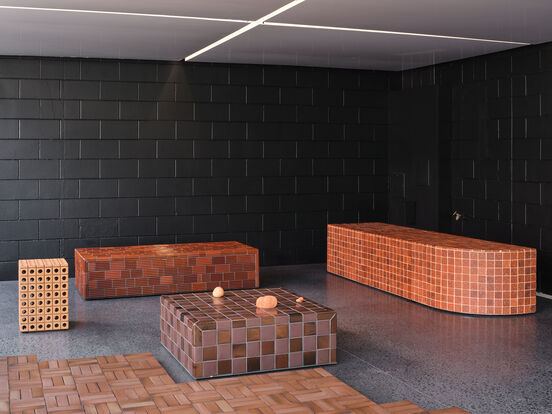
Ben Pyne, Mantle Overturn, 2023. Photograph by Sam Hartnett.
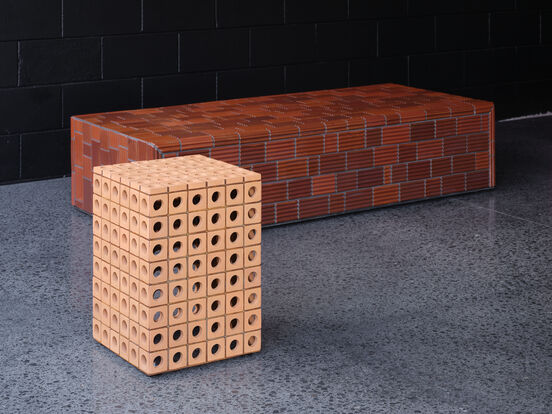
Ben Pyne, Perforated Clay Spoil (foreground) and Basalt and Bone Ash (background), both 2023
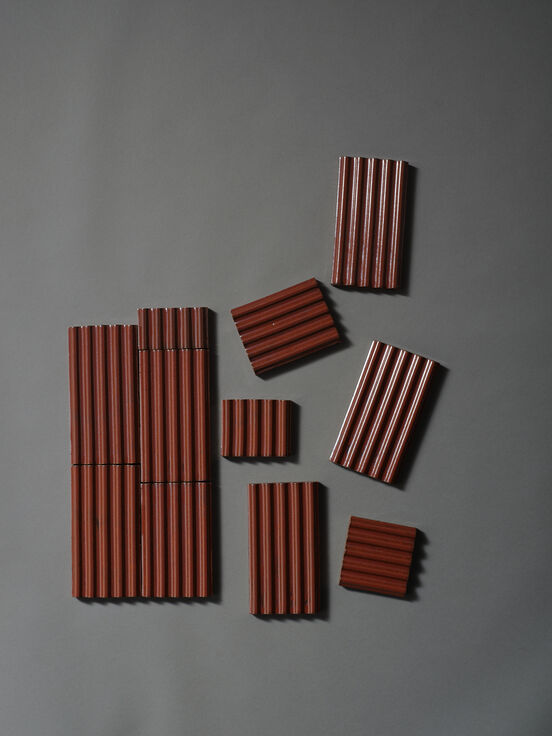
Ben Pyne, Test tiles for Mantle Overturn, 2022. Photograph by Sam Hartnett.
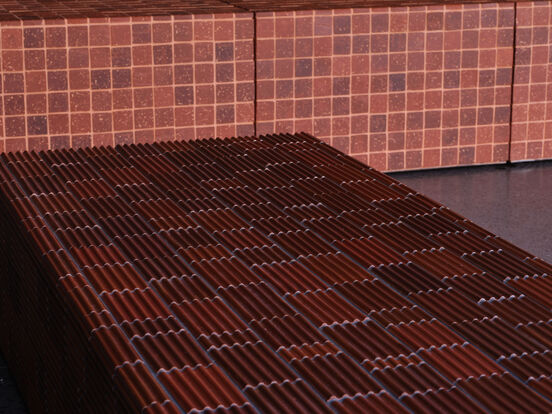
Ben Pyne, Basalt and Bone Ash (foreground) and Bullnose Brick Debris (background), both 2023
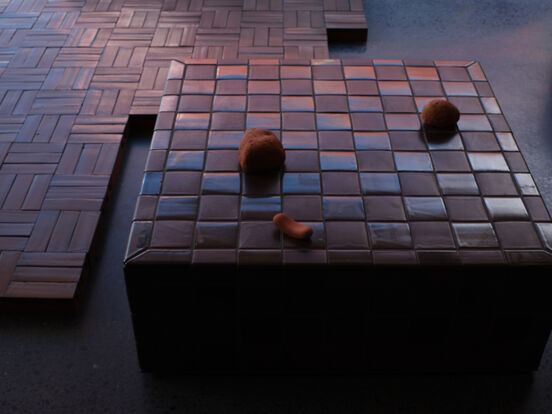
Ben Pyne, Brick and Basalt (foreground) and Basalt Floor (low fire) (background), both 2023.
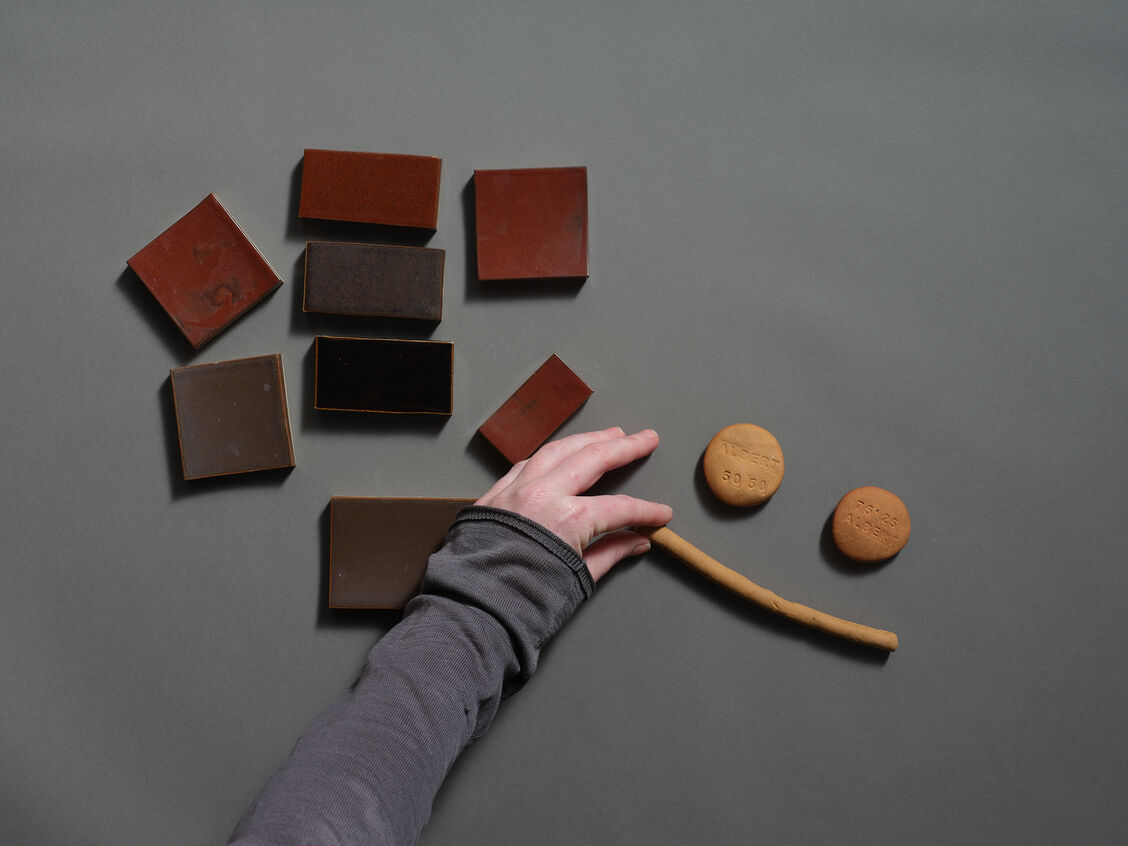
Ben Pyne, Test tiles for Mantle Overturn, 2022. Photograph by Sam Hartnett.